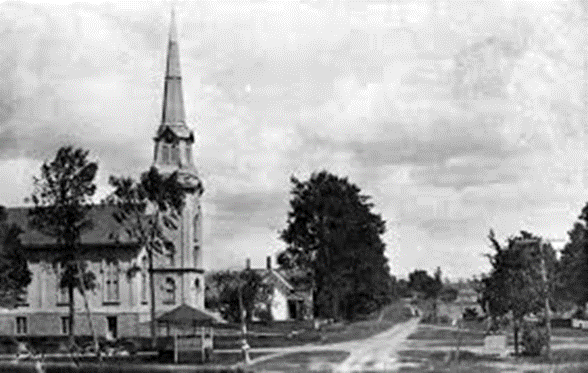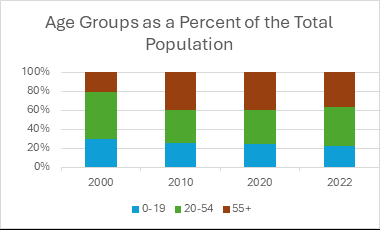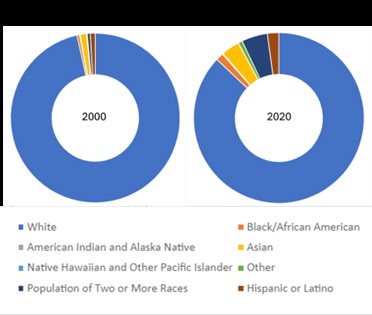Diversity is reflected in the demographics of the Town boards and staff.



Chapter 1
Williston's People
Introduction
Goals: In 2050, Williston is...
Livable
...because we create a strong, inalienable sense of belonging for everyone— we welcome all. We are sociable and kind. We recognize that a diversity of people contributes to a stronger, healthier, and more vibrant community. We create opportunities for all to participate and engage.
Resilient
...because different cultures approach problem-solving in diverse ways, and that diversity has an enriching effect on the town's innovation and resilience. We will therefore take steps to not only make our committees and boards more diverse, but we will create protocols that encourage innovative approaches to problem-solving, scenario planning, and conflict resolution.
Equitable
...because we are strong, resilient, diverse, tolerant, and balanced community. We are growing, expanding and becoming richer as a community because of this approach, offering abundant and diverse services for all. This Town Plan calls for implementing strategies and actions that further its commitment to diversity, inclusion, equity and anti-racism. One of the most powerful and impactful ways to do this is by taking steps to achieve a diverse representation among leadership positions including Town Boards, Committees, and staff.
Three Things to Know
WILLISTON IS GROWING AND WILL CONTINUE TO GROW
Williston has grown from the rural community of 1,484 it once was in 1960 to a town of 10,103 and an economic employment hub of greater Chittenden County.
WILLISTON'S PEOPLE ARE GETTING OLDER AND LIVING IN SMALLER HOUSEHOLDS.
The demographic makeup of Williston has shifted and people aged 55 and older now make up 40% of the population. This demographic shift is reflected in smaller households.
WILLISTON IS BECOMING MORE DIVERSE, IN MULTIPLE WAYS
While still predominantly white, Williston is becoming more racially and ethnically diverse. Diversity encompasses other characteristics such as economics and physical/mental/social capacities.
Three Things Public Engagement Told Us
WILLISTON'S PEOPLE VALUE ONE ANOTHER AND THE SENSE OF COMMUNITY IN THE TOWN
When people were asked what they valued most about "Williston's Homes and People," the greatest percentage of our survey respondents noted "community," the sense of community, its close-knit nature, the quality of community engagement in the town, and its friendliness to families and lack of "gated" communities.
WILLISTON'S PEOPLE VALUE THE UNIQUE QUALITIES OF THE TOWN
Williston is centrally located, and offers a range of stores and restaurants, with convenient access to Burlington and to a range of retail businesses. They also place value on Williston's effort to balance recreational access to its rural and natural qualities against the reality of needed commercial and residential development.
WILLISTON'S PEOPLE WANT ADDITIONAL HOUSING OPPORTUNITIES FOR A DIVERSIFYING POPULATION
To meet the demands of a shifting, diversifying population that includes all people, Williston needs more homes and more types of homes. Over half of the participants in the Town's 2023 "Williston 2050" public engagement process identified Affordable Housing as their first priority in the "Homes and People" category.
Williston is Growing and Will Continue to Grow

Figure 1: Williston Village Circa 1907-1915 with Federated Church and Williston Road in foreground. Credit: UVM Landscape Change Program (https://landscape.uvm.edu)
Population and Population Growth of Williston Since 1960 | |||||||
|---|---|---|---|---|---|---|---|
1960 | 1970 | 1980 | 1990 | 2000 | 2010 | 2020 | |
Williston | 1,484 | 3,187 | 3,873 | 4,887 | 7,650 | 8,698 | 10,103 |
10-year rate of change | - | 115% | 22% | 26% | 57% | 13.70% | 16.15% |
Chittenden County | 74,425 | 99,121 | 115,534 | 131,761 | 146,571 | 156,545 | 168,323 |
10-year rate of change | - | 33% | 17% | 14% | 11% | 6.80% | 7.52% |
Vermont | 389,811 | 444,732 | 511,456 | 562,758 | 608,827 | 625,741 | 643,077 |
10-year rate of change | - | 14% | 15% | 10% | 8% | 2.80% | 2.77% |

Williston's People are Getting Older and Living in Smaller Households

Williston is Becoming More Diverse, in Multiple Ways

Race/Ethnicity | Population | % of Population |
One Race | 9,594 | 94.96% |
White | 8,989 | 88.97% |
Black/African American | 149 | 1.47% |
American Indian and Alaska Native | 16 | 0.16% |
Asian | 356 | 3.52% |
Native Hawaiian and Other Pacific Islander | 3 | 0.03% |
Other | 81 | 0.80% |
Population of Two or More Races | 509 | 5.04% |
Hispanic or Latino | 223 | 2.21% |
Not Hispanic or Latino | 9,880 | 97.79% |
Total Population | 10,103 |
Objectives, Strategies and Actions
Objectives
All have equal opportunity and access to engage and participate in community activities, regardless of race, gender, financial circumstances, age, ability or any other identity defining characteristics.
The town integrates equity in all planning and policy implementation.
Williston's people are informed, engaged, and actively participating in building community.
Strategies
Identify and eliminate barriers to participation on Town Boards, Committees, and other volunteer opportunities
Seek broad representation on Town Boards and Committees by engaging and encouraging participation from individuals with diverse backgrounds and experiences.
Ensure inclusive hiring practices that promote broad representation across backgrounds and experiences.